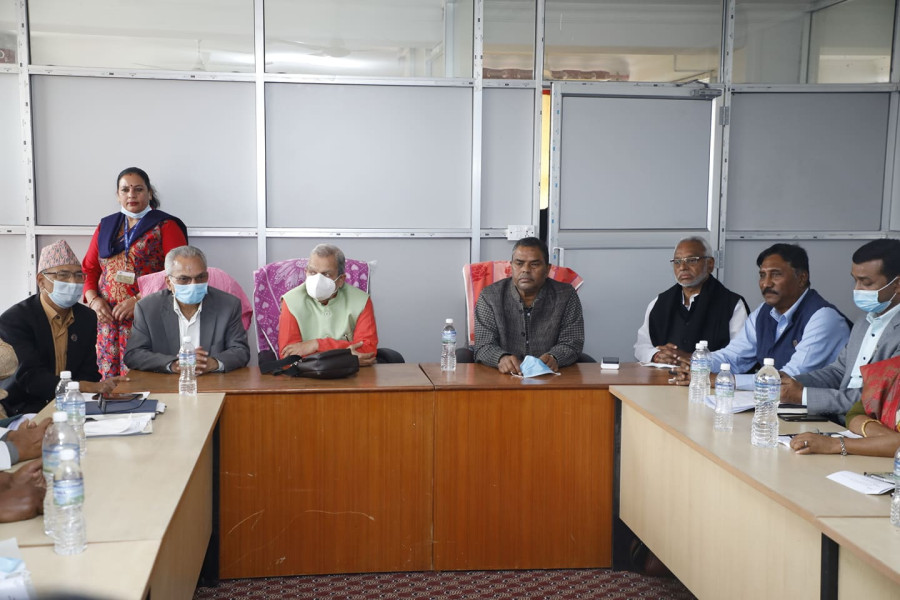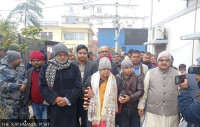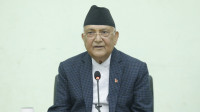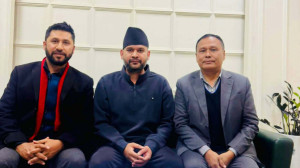Politics
As Janata Samajbadi rift grows, so does uncertainty over new coalition formation
While the Thakur-Mahato faction of Janata Samajbadi Party supports Oli, the Yadav-Bhattarai faction wants to join hands with the Congress and the Maoist Centre.
Anil Giri
The possibility of plum ministerial portfolios if it joins the government—as the key to Prime Minister KP Sharma Oli’s bid to continue in power—has apparently created a deep division within the Janata Samajbadi Party.
On Thursday top Janata Samajbadi Party leaders, including Mahantha Thakur and Rajendra Mahato, held a meeting in Kathmandu and formed a six-member task force to ‘settle the outstanding issues’ of the unification between Rastriya Janata Party Nepal and Samajbadi Party Nepal to form the Janata Samajbadi Party in April last year.
On Friday it was the turn of leaders of the former Samajbadi Party Nepal, formed in May 2019 with a merger between Sanghiya Samajbadi Forum Nepal led by Upendra Yadav and the Naya Shakti Party led by former prime minister Baburam Bhattarai to hold its own meeting.
While Thakur, chair of Janata Samajbadi Party, and Mahato, its senior leader, are in favour of joining the Oli government, Upendra Yadav, another party chair, and Bhattarai, president of the party’s federal council, are against it. They are in favour of joining hands with the Nepali Congress and the Communist Party of Nepal (Maoist Centre) to form the government.
With its 32 votes in the House of Representatives (two of its 34 members are suspended), the Samajbadi Party is the kingmaker. While officially the Maoist Centre continues to support the government as the incumbent Oli-led government was formed in February 2018 with its backing, the Maoist-Centre could withdraw support.
In that case, Oli would need just 16 more votes to survive and the Rastriya Janata Party Nepal faction could provide that. That would mean that Janata Samajbadi Party splits.
But leaders say the party is not going to split and it will make an appropriate decision on government formation when the time comes.
“For any new power sharing deal, we are the decisive factor but we are not divided,” said Raj Kishore Yadav, a leader of Janata Samajbadi Party. “We are not going to split and will take an appropriate decision when time comes.”
On Wednesday too, senior leaders from the former Rastriya Janata Party Nepal had held a similar meeting to discuss the future strategy of the Thakur-Mahato faction.
Ironically, the merger of the Rastriya Janata Party Nepal and Samajbadi Party Nepal last April was hastened by Oli’s issuing two ordinances–one related to the Political Parties Act-2017 which sought to ease provisions related to party split and registration of a new party. Fearing party split after introduction of the ordinance, the leaders of the two parties had come together and abruptly formed the Janata Samajbadi Party. The ordinances itself were withdrawn after widespread opposition to it.
It is the outstanding issues of party unification that the six-member task force is said to be mandated to look into.
“Earlier, we were not able to do enough homework to finish the party unity and so we are working to complete the remaining task of unification between us and the Samajbadi Party,” Keshav Jha, a member of the task force, told the Post.
“Our merger has not been completed so both sides—RJPN and SPN—are conducting parallel activities and there are clearly two factions in the party. This is known to every active member of the party,” a leader from the former Samajbadi Party Nepal said on condition of anonymity.
But within the party, there are suspicions about the intent of the task force.
“Although the mandate of the task force is said to identify the agenda of the party merger but its intent is to revive the dissolved RJP-N,” one former Rastriya Janata Party leader told the Post.
But according to Jha, the intent is not to revive the former Rastriya Janata Party.
Meanwhile, Bhattarai has spoken to Mahato to bridge the differences in the party, according to a leader close to Bhattarai.
Talks between the Thakur and Mahato faction and Oli have been going on a number of key demands of the Janata Samajbadi Party such as the release of its lawmaker Resham Chaudhary, who is serving a life sentence for his involvement in the 2015 Tikapur riots in which nine people were killed, release of the report of the Lal Commission on the atrocities that took place during the Madhesh movement in 2015-16 and constitutional amendments.
The Thakur and Mahato faction has been saying that Oli is positive towards addressing the demands of the Janata Samajbadi Party, an indication that it is not averse to supporting Oli in case there is a no-confidence motion against him or the Maoist Centre withdraws its support and Oli has to seek a vote of confidence in the House of Representatives.
On the other hand, the Samajbadi Party Nepal faction is, in principle, against joining hands with Oli as the party had called Oli’s move “undemocratic and unconstitutional” after he dissolved the House on December 20.
“Both RJPN and SPN had 17 parliamentarians each and if Thakur and Mahato decide to support Oli, then the number [who support Oli] could even reach 25,” said a leader from the rival Bhattarai-Yadav faction on condition of anonymity. “Then Oli will bring a law, which is already drafted, to facilitate party split in a way for them to revive the RJP-N.”
Given that the Janata Samajbadi Party is the kingmaker in the current power equation, even if there is a chance of forming a government by an alliance of Nepali Congress having 63 seats (two suspended), Maoist Centre with 53 seats and Samajbadi Party with 34 seats (two suspended), the Janata Samajbadi is likely to split, with the Thakur and Mahato faction unlikely to join such an alliance, according to another leader.
Former prime minister Bhattarai and Yadav are in close contact of Nepali Congress and Maoist Centre leaders for forming a new government led by Congress President Sher Bahadur Deuba, leaders privy to developments said.
“Since the Nepali Congress has not taken an official decision on leading a new coalition government, how can we lend our support to it?” Samajbadi Party lawmaker Mohammad Ishtiyaq Rayi told the Post. “It is true that we have two different political lines in the party but we are also waiting for a formal response from the Congress and Maoist Centre to our agendas.”
Its demands for amendment to the constitution and the release of Chaudhary are complex as it is not clear how that can be done without a consensus among all political actors. The amendment needs a two-thirds majority and Chaudhary has been convicted by court.
But with its position as the most important power player in the present scenario, the Samajbadi Party is a divided house.
“If we observe the developments, things are not going well inside the JSP,” said Tula Narayan Shah, an analyst who has been closely following Madhesi politics for a long time. “It looks like both factions are struggling to stay together.”
“The fate of JSP is instrumental for the future of the Oli government. Oli is the primary factor inside the JSP now. If the Maoist Centre withdraws its support to the government, it is sure Oli will rope in the JSP and survive. In that case, the Janata Samajbadi will split,” said Shah. “If the Nepali Congress and the Maoist Centre form the government too, the JSP is likely to be divided.”




 6.84°C Kathmandu
6.84°C Kathmandu














